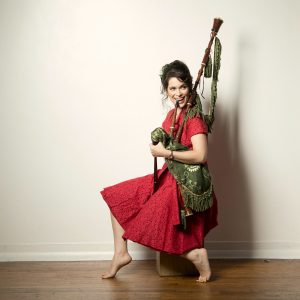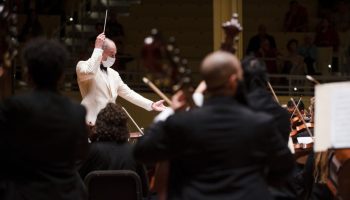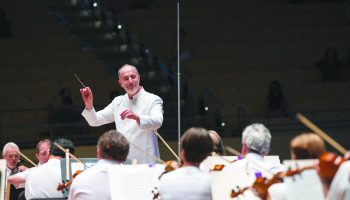
Cristina Pato knows what to expect when she tells people what she does for a living: a generous smile and lots of questions.
Pato is one of the world’s preeminent gaita (Galician bagpipes) players, an unusual profession to say the least. She’s accomplished both as a soloist on the instrument and as a member of the Silkroad Ensemble, which is in residence at Chautauqua Institution this week.
At 8:15 p.m. Thursday, Aug. 9, in the Amphitheater, Pato will join the Chautauqua Symphony Orchestra and Music Director Rossen Milanov for the U.S. premiere of Octavio Vázquez’s concerto for Galician bagpipes and orchestra, “Widows of the Living and of the Dead.” After intermission, Milanov and the CSO will perform Tchaikovsky’s Manfred Symphony in B-minor, op. 58. Musicologist David Levy will give a pre-concert lecture at 6:45 p.m. Thursday, Aug. 9, in the Hurlbut Church sanctuary, joined by Vázquez and Pato.

Pato began playing the gaita when she was 4 years old, at a time when the instrument was a symbol of communal identity in her homeland of Galicia, a region in northwestern Spain. Pato was born shortly after Spanish dictator Francisco Franco died, and Galician cultural artifacts — such as the gaita — were undergoing a revival.
“Playing bagpipes (in Galicia) in the ’80s was pretty much the thing to do. Either you played soccer or you played bagpipes, and I chose bagpipes,” Pato said. “Just to give you an idea, I come from a city of 100,000 people, and 10,000 of them in my generation were involved in bagpipes somehow. It was very popular.”
The gaita was not new by any means in the ’80s — according to one scholar, references to the bagpipes appear as early as the Old Testament. Americans are likely to recognize the Celtic bagpipes, Pato said, but the gaita has been the traditional instrument of shepherds throughout Europe and parts of Africa and Asia for centuries.
The gaita, Pato said, has been portrayed throughout history as an instrument traditionally played by men. There were female gaita players, according to Pato, but they were less visible in historical accounts.
Pato changed that in 1998 when she released her solo gaita album, becoming the first woman to do so.
“When I released my first album 20 years ago as a bagpiper, it was just because I was happy to do the music I liked to do, which was a mixture of pop and rock and heavy metal with the bagpipe,” Pato said. “All of the sudden, that became my career.”
Soon afterward, Pato was playing 100 shows a year as a solo bagpiper. She didn’t expect this career path; Pato had been training as a classical pianist for years, ultimately earning her doctorate in collaborative piano from Rutgers University.
“I always felt there was some sort of wall between folkloric music and classical music. I can do things with the bagpipes that I cannot do with the piano and the other way around,” Pato said. “I’ve enjoyed being able to navigate between those two worlds and find the connections and beauty in both.”
Through her engagements as a pianist, bagpiper and member of Silkroad Ensemble, Pato has been exploring those connections for over a decade. About 10 years ago, she began the Gaita and Orchestra Commissioning Project, an effort to fund music for her instrument and orchestra.
The piece she will perform this evening — Vázquez’s “Widows of the Living and of the Dead” — is a result of that project. The title comes from Follas novas (Fallen Leaves) by poet Rosalia de Castro, whom Pato describes as the muse of Galician culture.
The piece is an ode to Galicia’s history of women upholding Galician society after men left for war or to foreign countries for work. This was very common in the 19th century, and as a result, many women were left as the lone heads of their households.
“Metaphorically speaking, Galicia is a matriarchal society,” Pato said. “This concerto, because of (Vázquez’s) knowledge of my love of Rosalia de Castro, is focused on that particular story of powerful, strong women that have been carrying the history of Galicia for centuries, even though they were always invisible.”
For Vázquez, the story of Galician women carries both Galician and universal importance.
“It’s dedicated to these Galician women that moved forward in spite of the very harsh conditions they had, so it’s an homage to their spirit,” Vázquez said. “But that homage is not an inward-looking thing; it extends to all women throughout history.”
Tchaikovsky’s Manfred Symphony will close the program. The symphony is a lesser known work of the composer’s and is not often performed.
Milanov said he doesn’t know exactly why that is, but he has a theory: the work clocks in at around 55 minutes, which is longer than would fit on a single LP. Milanov thinks this played a role in what pieces did and did not become popular throughout the 20th century.
Despite its relative obscurity, the Manfred Symphony is a personal favorite of Milanov’s. It’s incredibly rich, he said, with intense and dramatic opening and closing movements and middle movements that represent “beautiful studies in orchestration.”
“Tchaikovsky had the audacity to really show his innermost world to the audience from the stage without wearing some sort of a mask,” Milanov said. “That’s something quite unique, and I think sometimes people do not fully appreciate how much personal importance it was to Tchaikovsky to have that ability of sharing very personal, emotional content.”





